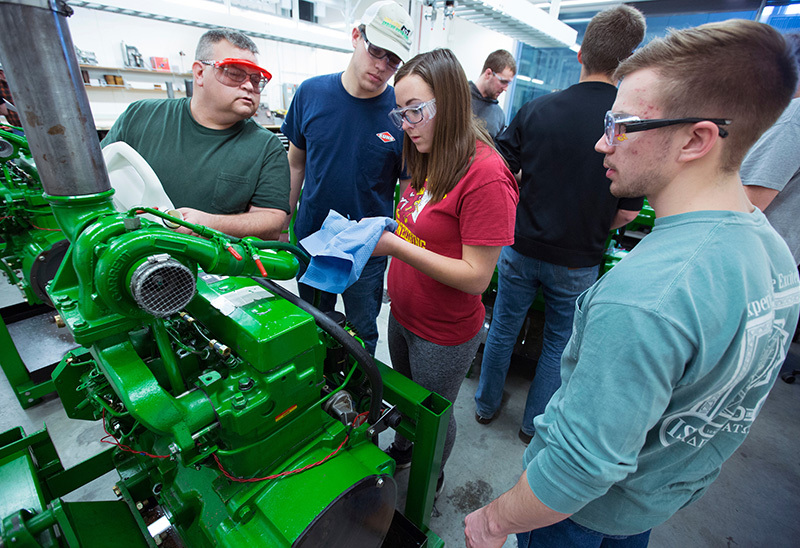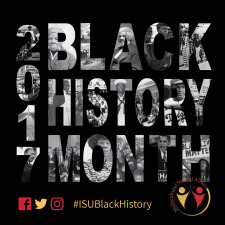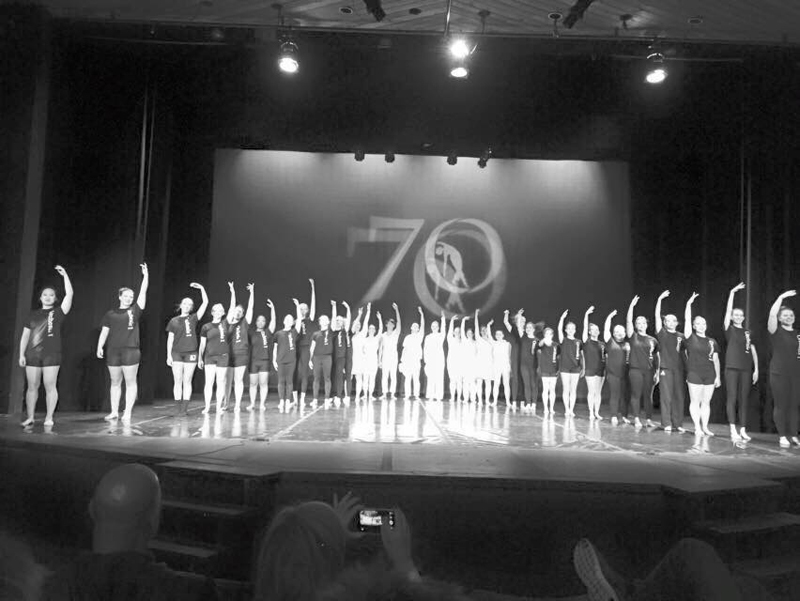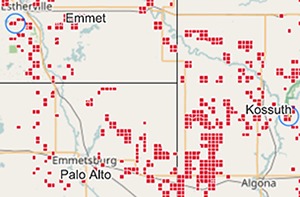Humming

Photo by Christopher Gannon.
(l-r) Agricultural engineering senior Jim Renoe, junior Grant Heineman, senior Heather Hoefling and junior Jon Roettger inspect the oil level on their tractor engine during a lab exercise Monday for their Agricultural Tractor Power class in Sukup Hall. Their task that day? Service the engine and get it running efficiently.
Half of $8 million mid-year cut will be absorbed centrally
Iowa State units collectively have to identify $8 million in cuts to the current budget, following the Iowa Legislature's passage of a de-appropriation bill that responds to the state's revenue shortfall. Gov. Terry Branstad signed the bill on Wednesday.
To meet an estimated $117.8 million revenue shortfall for the fiscal year that ends June 30, legislators identified $88.2 million in cuts to targeted state units, about $25.1 million in transfers from specialty funds and a $4.5 million adjustment to property tax credits.
"Any cuts to our state appropriations are detrimental," said President Steven Leath. "Our unique land-grant obligations -- preparing an educated workforce, creating new knowledge, sharing knowledge to improve Iowans' lives and the state's economy -- take money. And so we will continue to ask the governor and the general assembly to make higher education a priority."
Leath said the primary goal in meeting the reduction is to minimize the impact on Iowa State students, both this spring and in the future. As first announced last month, these will be the key strategies used:
- Postponing nonessential deferred maintenance and repairs
- Delaying some searches or eliminating vacant positions
- Reducing expenditures for professional development, equipment, travel, printing and communications
- Reducing some campus-wide services temporarily
Chief financial officer Miles Lackey said about $4.2 million will be absorbed centrally, including the president's units, primarily by postponing some nonessential equipment purchases and deferred maintenance projects such as renovation plans for the Scheman Building. The remaining reduction has been distributed among Iowa State's other divisions: academic affairs, student affairs, university services and finance.
Senior vice presidents were asked to submit reduction plans for their divisions to Lackey early next week to meet the deadline set by the de-appropriation legislation. Lackey said he would have more detailed plans to share within a week or two.
Iowa, UNI cuts
The University of Iowa also faces an $8 million state funding cut, while Northern Iowa will receive $2 million less than originally appropriated.
The cuts are not one-time reductions, but instead will reset appropriation bases. For example, if Iowa State applies the full reduction to its general university appropriation ($184.4 million this year), that creates a 4.3 percent reduction to that funding source heading into FY18 budget planning.
Land-grant hunt is on

Sue and James Francois (center) of Barnum own the first land-grant parcel leased in Iowa, perhaps the country. Also pictured are Jerry Chizek, extension and outreach regional director, and Krystal Doolittle, farm blogger and part of a Hamilton County family that owns land-grant land. Contributed photo.
The settlers who moved onto the 160-acre parcels of land-grant land in northwest Iowa in the 1800s may or may not have known that their land payments were helping finance the ag college in Ames.
A century and a half later, the 204,000-plus acres of Iowa land-grant grounds are virtually unknown to their current owners. Iowa State University Extension and Outreach staff are working to change that.
"We want to let these land owners know about their special connection to Iowa State and land-grant history," said vice president for extension and outreach Cathann Kress. "We also hope they'll share, for our archives, their history of growing up on this land and caring for it."
Iowa State is the first land-grant university to identify and map the parcels that the federal government gave to states under the Morrill Act of 1862. States receiving the federal gift had to promise to use the proceeds of that land to build "people's colleges," where working-class students could get both a practical science and liberal arts education.
Request prompts historical dig
Extension's Land-Grant Legacy Project began with a simple request to Kress. An ISU alum in the Norwalk area believed his family farm might be part of the state's land-grant allocation and asked if extension staff could confirm that.
Turned out the farm wasn't on Iowa land-grant property, but in the process of checking, researchers found several old documents referencing Morrill Act parcels and an idea was born: Locate the original land-grant parcels and connect with the people now tending that land.
Since then, extension staff and volunteers have combed old records -- mostly reports to trustees of the old Iowa State Agricultural College and Farm -- to come up with likely land-grant grant parcels.
Ray Hansen, director of the Agricultural Marketing Resource Center, led the effort to find and plot the land-grant property on an online map, built by ISU's geographic information systems staff. The map displays the parcels, with township, range and section details and information about first leases and value estimates. Generally, land was leased for several years, then purchased, Hansen explained.
Clues in the abstracts
Through the Land-Grant Legacy website, Hansen said, extension staff are seeking help from current landowners to confirm that the suspected land parcels are, in deed, land-grants.
"That can only be confirmed by abstracts or courthouse records," he said.
Property owners, particularly those in northwest Iowa, are urged to view the land-grant map, and, if they find their properties there, to check their abstracts, Hansen said.
Good indicators of land-grant ground are phrases like:
- "United States to State of Iowa Agricultural College"
- "Morrill Act"
- "Act of Congress, July 2, 1862"
Owners can validate land-grant property and share the history of their land and their own connections with Iowa State on online forms, Hansen added.
Lots of land-grant barons yet to be found
Extension recognized families who own validated land-grant properties in 13 northern Iowa counties during the Clay County fair last September. There are plenty more owners to be found, Hansen said.
"Through this land-grant legacy project," Kress said, "we're determined to find and tell these stories, sharing the legacy of the land and the people who helped to build Iowa State University."
Related story
Northwest Iowa: Land of the land grants, Jan. 26, 2017
Events note Black History Month

Several campus activities are included on multicultural student affairs' compilation of Black History Month events. Iowa State faculty and staff nominated by students also will be featured each Wednesday this month in a spotlight feature recognizing support and advocacy for black students. Events are free and open to the public, unless indicated.
Black History Month events
- Feb. 1-28, "Black History Month: Writings Across the Diaspora," display and featured collection (Fireplace Reading Room, Parks Library)
- Feb. 2, Performance, Los Angeles-based comedian Solomon Georgio (9 p.m., Memorial Union Maintenance Shop)
- Feb. 3, Black Jeopardy, hosted by the Black Graduate Student Association (6 p.m., Black Cultural Center, 517 Welch Ave.)
- Feb. 9, Soul Food Lunch, educational displays and menu selections (11 a.m.-2 p.m., Seasons, Marketplace and Conversations dining halls)
- Feb. 9, NPHC 101, learn about historically black fraternities and sororities (8 p.m., 0001 Carver)
- Feb. 16 and 17, The Vagina Monologues, raising awareness about violence against women and girls (7 p.m., MU Sun Room), $10-$13
- Feb. 20-March 6, "Products of a Creative Mind" exhibit, online and in person (African American Museum of Iowa, Cedar Rapids), $2.50-$5
- Feb. 20, Lecture, "In the Shadow of Charleston: Reflections on Race, Racism and Racial Violence," Keisha Blain, assistant professor, University of Iowa (7 p.m., MU Great Hall)
- Feb. 24, Discussion, "The Same But Different: The Divide Between Africans and African Americans" (7 p.m., 205 Carver)
- Feb. 25, 16th Annual Social Justice Summit, for students (9 a.m.-3 p.m., MU Campanile Room), registration required
- Feb. 26, Soul Food Sunday, hosted by the Black Student Alliance (5 p.m., Black Cultural Center), limited space available, email Malik Burton for information
- Feb. 28, Film and discussion, "A Place of Rage" documentary (7 p.m., 268 Carver)
71 years and counting

Dancers celebrated the 70th anniversary of Barjché in 2016. Contributed photo.
What's in a word?
In 1944, Iowa State students Barbara Sgarlat Drexler, Jean Ringoen Williams and Charlotte Ann Stuart created Barjché, a name derived from the women's first names.
Modern dance enthusiasts will have three chances to see Iowa State's 71st annual performance of Barjché (pronounced bar-SHAY) at Fisher Theater on Feb. 3 and 4 (7:30 p.m.) and Feb. 5 (2 p.m.).
Produced by the Orchesis I Dance Company, Barjché's 2017 theme is individuality and interconnectedness, which will be reflected through the dances created by the dance company members, faculty and guests. Guest choreographer and professional dancer Chris Black, San Francisco, created a piece for the show during her weeklong residence at ISU last fall. Other featured choreographers include Barjché artistic director Cynthia Adams and current Orchesis I members.
Orchesis I alumni also will pay tribute to former ISU faculty member Laurie Sanda, who passed away last year, with a performance of "Field Day," a dance originally choreographed by Sanda in 2002.
Tickets are $12 ($10 for students) and available at the Iowa State Center ticket office or through Ticketmaster.

